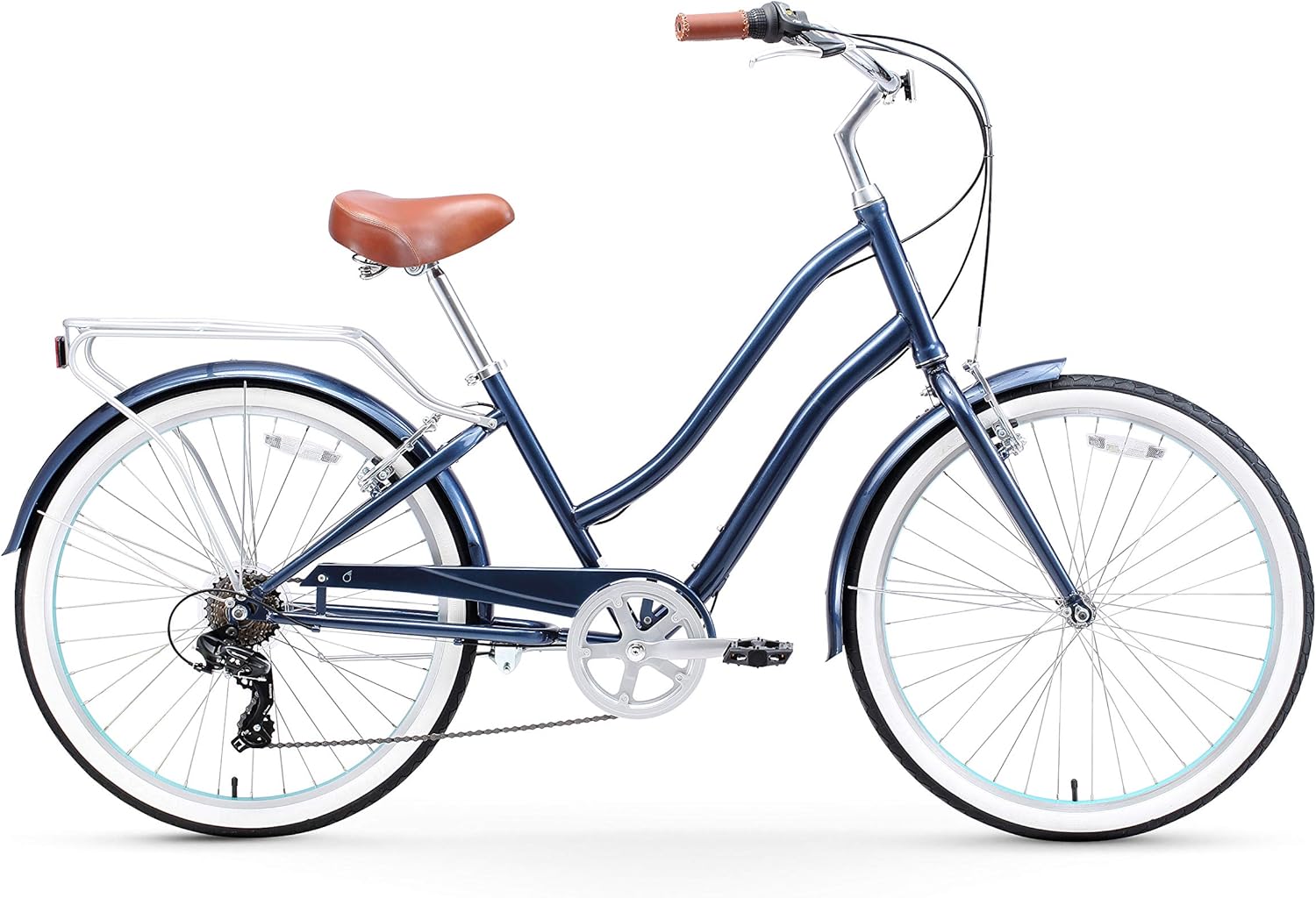Cycling continues to grow in popularity especially as your convenient commuter, and it’s easy to see why. With environmental concerns at an all-time high, many people are drawn to cleaner modes of transportation, and bikes are the king of green transit.
That said, not all bikes are created equal and a wrong decision can leave you with the wrong bike.
While they are all far cheaper than cars, some of them can be costly.
On the other hand, choosing the wrong budget bike for commuting can leave you with a poorly performing machine that doesn’t last a year.
Wading through all the options can be a complicated headache, but luckily for you, this article collects the top ten sub $500 bikes in one place.
This list contains bikes for men and women, hybrids, fixies, and multi-speeds. Several of the listings have weight capacities at or in excess of 300 lbs.
Whether you are a new rider, or an old hand looking for a fresh set of wheels, you’ll find something below that suits your needs — and meets your price.
What Are The Qualities of a Good Student Bike?
When it comes to choosing a bike for commuting from home to school or college, safety and durability should be top priorities.
It may be tempting to go for the cheapest option, but it’s important to keep in mind that cheaper bikes may not have the necessary features to keep you safe while riding.
While it’s not necessary to splurge on a fancy bike, investing in a solid and reliable option will save you trouble and money in the long run.
For shorter distances, a single speed bike can be a cheaper option that saves on maintenance.
Hybrid bikes are also great for city commute, especially on a budget. Some also prefer a cruiser or budget electric bike for the same for their ease of use.
However, no matter which type of bike you choose, it’s crucial to invest in a good bike lock to prevent theft on college campuses where incidents are common.
The Must-Have Features of a Student Bike
- Simple, lightweight and strong.
- Cheap in price but not in product / parts.
- Easy to maintain and use.
- Not so fancy, but looks OK.
- Durable and last long ( at least for 3 years ).
- Should have or easily fit a pannier rack for your stuff.

sixthreezero EVRYjourney Steel
( Best Over-All )
The sixthreezero EVRYjourney is the perfect bike for students who are looking for a comfortable and reliable ride to and from college or school.
With a combination of comfort and commuter bike features, this bike is suitable for weekend rides with friends or quiet rides on your own.
The seat is padded and comfortable, the brakes and gears respond smoothly, and the ergonomic pedal placement ensures pleasant rides every time.
It’s designed specifically for women, making it one of the best options in the market. Even if you are looking to buy this as a man, it can be a great commuter for short distance.
You can go the distance on various terrains with ease; whether you’re commuting or running errands, the bike is equipped with fenders and a back rack for panniers to carry your belongings.
The brakes offer enough control and stopping power in varied conditions and tires handle pavement, dirt, gravel, and grass equally, so you can ride safe all the time!
Height Range | Weight Capacity | Frame Material | Gears | Pannier Rack |
5′ to 6’2″ | 300 lbs | Alloy Steel | 7-speed | Yes – ✅ |

Hiland Fixed Gear Road Bike
( Least Expensive )
The Hiland Fixed Gear Road Bike is the perfect choice for college students on a budget. With its simplistic design and retro aesthetic, this bike is not only practical but attractive as well.
The steel frame ensures durability, while its lightweight construction allows for easy transportation around campus.
Fixed gear bikes are also efficient in cities with flat landscapes, making it an ideal option for students who live in urban areas.
What’s more, the bike is compliant with American bicycle standards and has passed CPSC 16 CFR 1512 Requirement.
With its affordable price point, this bike doesn’t come with extra components, making it even lighter for easy maneuvering.
While the pedals may be cheap, they’re replaceable, making it easy to customize and maintain.
Overall, the Hiland Fixed Gear Road Bike is the perfect balance between practicality and affordability, making it the ideal option for college students.
Height Range | Weight Capacity | Frame Material | Gears | Pannier Rack |
5’5” to 6’2″ | 230 lbs | Alloy Steel | Single Speed | No – ❌ |

Specialized Sirrus 2.0
( Last The Longest )
Looking for a durable and reliable bike that will last you through college and beyond? Look no further than the Specialized Sirrus 2.0.
This bike offers a stable ride thanks to its 32mm tires, and its lightweight frame makes it easy to carry up and down stairs.
Whether you primarily ride on paved trails or dabble in light gravel, the Sirrus 2.0 offers snappy gear shifting and a speedy ride with minimal effort.
And with a solid entry level price point, the Sirrus 2.0 strikes a good balance between cost and quality. There can’t be a better entry level bike for serious riders.
Need proof of its longevity? Many riders, including myself, are still riding Sirrus bikes from nearly a decade ago and are still thoroughly enjoying them.
Height Range | Weight Capacity | Frame Material | Gears | Pannier Rack |
4’11” to 6’4″ | 250 lbs | Aluminum | 8-speed | No – ❌ |

Sole Bicycles Overthrow II
( Lowest Maintenance )
The Sole Bicycles Overthrow II is an excellent choice for anyone seeking a low-maintenance ride.
These bikes are simple in design, with fewer moving parts than traditional bicycles, so there’s less chance of something going wrong.
And if something does break, it’s easy to fix and won’t affect your budget.
The Overthrow II, in particular, is a great option for daily commuters looking for an efficient, stylish ride. It’s lightweight, fast, and designed for speed – perfect for getting around town quickly.
The messenger-style riser handlebar and narrow grip stance make for an aggressive, natural riding position that’s ideal for those who want to take their cycling to the next level.
Overall, the Sole Bicycles Overthrow II is an excellent choice for anyone looking for a reliable, affordable fixie to commute from home to school or college.
Height Range | Weight Capacity | Frame Material | Gears | Pannier Rack |
5’0” to 6’4″ | 275 lbs | Hi Tensile Steel | Single speed | No – ❌ |

Ride1Up Roadster V2
( Best Electric )
The Roadster V2 electric bike has been gaining popularity among students for a variety of reasons.
With a completely concealed battery and quiet motor, onlookers will have no idea how you’re able to pedal so fast.
This class 3 electric bike can reach up to 24 mph on pedal assist thanks to its efficient 350w geared hub motor with 40nm torque.
It also has a range of 20-30 miles and is built with frame geometry and components for optimal road performance.
Despite its electric capabilities, the Roadster V2 looks and feels like a traditional bike. Its minimalist and beautiful styling is matched by excellent craftsmanship.
Riders are raving about the fantastic ride experience and how light, stealthy, and quiet it is. In fact, some have even reported riding 3000 miles on the Roadster V2 without any issues.
Height Range | Weight Capacity | Frame Material | Gears | Pannier Rack |
5’3″ to 6’3″ | 300 lbs | Aluminum Alloy | Single speed | No – ❌ |
What to Look for When Buying a Student Bike
Buying a student bike is an important decision. It should be well-researched and planned to ensure that the rider is comfortable, safe and able to enjoy their cycling experience.
Here are some points to consider when choosing a student bike: Frame Materials: The frame material of a bike affects its overall strength, weight
Frame Materials
The frame material of a bike affects its overall strength, weight and stiffness. Steel frames are strong, but tend to be heavier than aluminium or carbon fibre frames.
Aluminium frames offer a lighter ride while still providing good strength and durability. Carbon fibre is the lightest option available with excellent stiffness for maximum power transfer.
Bike Fit
Choosing a bike with the correct fit is essential for a comfortable and efficient ride. The frame size should be appropriate for the rider’s height and reach, and adjustments can be made to make sure the saddle height, handlebar position and other contact points are correctly adjusted.
Features & Customization
Bikes come with a variety of features that may be necessary for a student rider.
Different brake systems can provide different levels of control, and gearing options will vary depending on the terrain to be ridden.
Look for customization options that can help tailor the bike to a specific riding style or needs.
If you’re set on a model, but it doesn’t come with the rack, water bottle holder, headlights, or other feature you want, check the specs for the appropriate connection point.
Suspension
Suspension systems are used to absorb shocks from rough terrain, helping to ensure a smoother ride and reduce fatigue.
Some suspension systems are designed for downhill riding or other specialized types of riding, so make sure to investigate the features available on any bike you’re considering.
Saddle
Comfort is a key factor when it comes to selecting a saddle. Make sure that your chosen model has sufficient padding and adjustability to suit your needs.
Gears
A wide range of gears can be advantageous in hilly terrain or for more experienced riders who want to go faster. On another hand having a single speed fixie can be great for city commute and keeping a low maintenance.
A seven-speed bike has 7 gears meaning there are seven levels of speed. The lower gears are great for efficiency while the higher gears will help with performance.
Fenders and Brakes
Fenders are a great addition for wetter climates, helping to keep the rider dry.
Disc brakes offer better performance in wet conditions compared to rim brakes, and hydraulic disc brakes offer the best stopping power. Make sure the bike you choose has an appropriate braking system for your location and riding style.
Ultimately, choosing a student bike is about finding a balance between comfort, safety and value for money. Take time to research different models before investing in one.
Frequently Asked Questions
Q.1 What bikes are best for commuting?
Choosing the best type of bike also depends on the type of riding involved in your commute. If you’ll be riding through a predominantly urban area, a city bike or fixie would be ideal options.
They tend to have more robust frames and wider tires for dealing with curbs and uneven pavement and are built more for control than speed.
On the other hand, for commutes involving long distances on paved roads, a road or comfort bike is the better choice. Road bikes allow you to reach high speeds at a low cadence, while comfort bikes have wider seating and other creature comforts making even the longest rides easy.
Q.2 How much should I spend on a commuter bike?
The rule of thumb is that you can expect to pay roughly $500 for a commuter bike that will perform well and last for a decent amount of time.
This doesn’t mean that everything at a lower price range is bad, but rather that the components and materials used in their construction are often cheaper and may break down sooner.
However, budget bikes can last as long as more expensive bikes with proper maintenance.
It’s important that they’re ridden as intended as well. Yet, even if you take every precaution, don’t expect a bike at a sub $300 price point to match the performance of a more expensive ride.
Q.3 Are commuter bikes good for long-distance rides?
Commuter bikes can be good for long-distance rides. Remember, many types of bikes can be sold as commuter bikes, and some of them, like city bikes; are better suited to the frequent stopping and short distances of urban environments.
Road, comfort, and touring bikes are each made to maximize the efficiency of long-distance cycling. Each of these can serve as an excellent commuter bike for a long-distance commute.
E-bikes are another good option. Provided they have the functional range to complete a long trip, e-bikes can actually extend the distance you can comfortably travel, albeit for a higher price.
Q.4 How heavy should a commuter bike be?
As with practically every other facet of choosing a bike, what counts as an acceptable weight depends upon personal preference and ability.
A weight of 30 lbs is generally considered to be a mid-range average for most bikes, with 40 lbs entering into the heavier range. High end, carbon fiber or titanium bikes can weigh as little 15 lbs, but you pay for that benefit.
While lighter is better, ultimately, the ideal weight is that which you can comfortably handle, both when steering, and when it is necessary to carry the bike.
Also Read,
Best Schwinn Hybrid Bikes 2022 – Review & Comparison
Best Small Handlebar Bags (Burrito Bag) For Commute & Travel









Leave a Reply